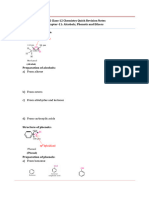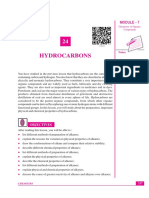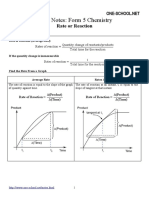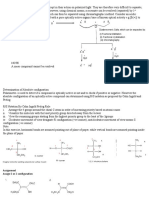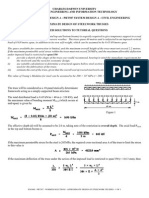0 ratings0% found this document useful (0 votes)
10 viewsOrganic Chemistry Concept Map
Organic Chemistry Concept Map
Uploaded by
PuraniCopyright:
© All Rights Reserved
Available Formats
Download as PDF, TXT or read online from Scribd
Organic Chemistry Concept Map
Organic Chemistry Concept Map
Uploaded by
Purani0 ratings0% found this document useful (0 votes)
10 views1 pageOriginal Title
Organic_Chemistry_concept_map
Copyright
© © All Rights Reserved
Available Formats
PDF, TXT or read online from Scribd
Share this document
Did you find this document useful?
Is this content inappropriate?
Copyright:
© All Rights Reserved
Available Formats
Download as PDF, TXT or read online from Scribd
Download as pdf or txt
0 ratings0% found this document useful (0 votes)
10 views1 pageOrganic Chemistry Concept Map
Organic Chemistry Concept Map
Uploaded by
PuraniCopyright:
© All Rights Reserved
Available Formats
Download as PDF, TXT or read online from Scribd
Download as pdf or txt
You are on page 1of 1
Created by Unlicensed Version
Similar chemical properties
Gradation in physical properties
Homologous series
Successive members of a homologous series differ by a -CH
2 group
Primary alcohols
Same general formula
Oxidation of alcohols Secondary alcohols(ketone)
CnH2n+2 color change:orange-> green
therefore react in the presence of 2CH3OH(l)+3O2(g)-> 2CO2(g)+ 4H2O(g)
a strong source of energy enough contains only strong C-C bonds Alcohols Combustion
to break these bonds 2C5H11OH(g)+15O2(g)-> 10CO2(g)+12H2O(g)
alkanes are stable under most conditions (low reactivity)
therefore molecules are not susceptible CnH2n+1OH
non-polar
to attack by most reactants -OH group is polar, increases in solubility in H2O of the molecules,relative to alkanes of comparable molar mass
highly exothermic addition reactions would involve disrupting
reluctant to undergo addition reactions
C3H8(g)+5O2(g) -> 3CO2(g)+ 4H2O(g) the entire cloud of delocalized -e
2C3H8(g)+7O2(g) -> 3CO(g)+ H2O(g) does not behave like other unsaturated molecules no isomers
C3H8(g)+2O2(g) -> 3C(g)+ 4H2O(g)
C6H6 indicates a high degree of unsaturation ( >alkanes & alkenes)
CO2 & H2O are greenhouse gases
absorb Infrared and contribute to global warming & climate change Combustion reaction cyclic structure
Alkanes framework of single bonds attaches each carbon to one on one e- leaves on each C atom
CO is a toxin the special stability of the benzene ring is the result of
it combines irreversibly with the haemoglobin in blood and prevents it from carrying2 O either side and to a hydrogen atom they are delocalized through all 6 C atoms
Benzene delocalized electrons delocalization of e- in benzene produces
Carbon soot is released into the air as particulates each carbon forms three single bonds with bond angles
of 120 foming the planar shape a symmetrical "cloud" of e- charge above
have a direct effect on respiratory system Oraganic Chemistry
and below the plane of ringvery stable
also act as catalysts in forming smog in polluted air and as the source of global dimming Created by Unlicensed Version
bond length all C-C bond lengths in benzene are equal and intermediate in length between single and double bonds
CH4(g)+Cl2(g)-> CH3Cl(g)+HCl(g) electrophiles are reactants that are themselves e- deficient as they have a positive charge,
in the presence of UV light they attracted to the electron-rich benzene ring
Electrophilic substitution reaction
Initiation: NO2+ derived from HNO3
Cl2 -> 2Cl• radicals Examples
Propagation: benzene with halogens
Cl• +CH4-> CH3• + HCl CnH2n+1X
CH3•+Cl2 -> CH3Cl+Cl• Substitution reaction:
CH3Cl+Cl• -> CH2Cl• +HCl Halogenoalkanes A nucleophile is an e- rich species that is attracted to parts of molecules that are- edeficient
Halogenation
Termination: Nucleophilic substitution attracted to the e- deficient carbon atom in the halogenalkanes
Cl•+Cl• -> Cl2 The hydroxide ion, OH- is a good nucleophile
CH3•+Cl• -> CH3Cl
CH3•+CH3•->C2H6 Name alcohol then carboxylic acid
A free radical contains an unpaired -e Esterification Carboxylic acid + alcohols ester + water
Homolytic fission occurs when a bond breaks by splitting the shared pair of e- between the two products Catalyst: con.H2SO4
CnH2n
Catalyst: Ni Addition reaction:
150 Hydrogenation
Alkenes
Addition reaction:
Halogenation
Hydration
Created by Unlicensed Version
You might also like
- SIMONE Software Equations and MethodsDocument58 pagesSIMONE Software Equations and MethodsReza GhanavatiNo ratings yet
- Summary of Account Activity Payment InformationDocument4 pagesSummary of Account Activity Payment Informationtaylor0% (1)
- Reservoir Simulation History Matching and ForecastingDocument60 pagesReservoir Simulation History Matching and ForecastingnoorNo ratings yet
- Hasan Sayginel: Edexcel A Level Organic ChemistryDocument41 pagesHasan Sayginel: Edexcel A Level Organic ChemistryDEEBANNo ratings yet
- Activity in Teaching Approaches in Secondary Social StudiesDocument3 pagesActivity in Teaching Approaches in Secondary Social StudiesNickson Anthony Bile92% (39)
- Book of Textile EngineeringDocument122 pagesBook of Textile EngineeringJuan Cubas0% (1)
- 1.2homologous SeriesDocument3 pages1.2homologous SeriesLyana TaylorNo ratings yet
- Hydrocarbons: Presenter: Shannon SmithDocument40 pagesHydrocarbons: Presenter: Shannon SmithShannon SmithNo ratings yet
- Organic Chemistry ReactionDocument3 pagesOrganic Chemistry ReactionGAMEPORIUMNo ratings yet
- Reactions of Aldehydes & Ketones: Oxidation & ReductionDocument4 pagesReactions of Aldehydes & Ketones: Oxidation & ReductionjnfjngsdjNo ratings yet
- Types of Chemical Reactions and Balancing EquationsDocument2 pagesTypes of Chemical Reactions and Balancing EquationsSamantha Collyn GomezNo ratings yet
- Ether (Theory) Module-4Document7 pagesEther (Theory) Module-4Raju SinghNo ratings yet
- 2022 JC2 H2 Organic Concept MapsDocument13 pages2022 JC2 H2 Organic Concept MapsPriyaNo ratings yet
- 1714246684533772Document3 pages1714246684533772kaikhasraw09No ratings yet
- Alkanes Alkenes AlkynesDocument2 pagesAlkanes Alkenes AlkynesGAMEPORIUMNo ratings yet
- O R C H O R C R: Carbonyl Compounds (Aldehydes and Ketones)Document10 pagesO R C H O R C R: Carbonyl Compounds (Aldehydes and Ketones)Fakin AsholNo ratings yet
- Ya IniDocument20 pagesYa IniFadhla Fadhilatul Mariyatis SolihahNo ratings yet
- Organic MoleculesDocument6 pagesOrganic Moleculeskoketsomahlobogoane637No ratings yet
- 2017 Chemistry NotesDocument27 pages2017 Chemistry NotesOpalNo ratings yet
- Organic ReactionsDocument5 pagesOrganic ReactionsThemba SathekgeNo ratings yet
- Unit 6 Reaction of Functional Groups - A SummaryDocument3 pagesUnit 6 Reaction of Functional Groups - A SummaryklahaNo ratings yet
- Alkenes LectureDocument26 pagesAlkenes Lectureasiyabashirbaloch143No ratings yet
- Reactions in Organic ChemistryDocument31 pagesReactions in Organic Chemistrysubh opNo ratings yet
- Chem 4Document107 pagesChem 4JinyoungNo ratings yet
- Haloalkanes and Haloarenes (Revision Notes)Document39 pagesHaloalkanes and Haloarenes (Revision Notes)saapldesign1 1No ratings yet
- Ch04 - Reactions in Aqueous SolutionsDocument55 pagesCh04 - Reactions in Aqueous SolutionsMorningNo ratings yet
- Alkanes and Alkene BrochureDocument3 pagesAlkanes and Alkene BrochurekinaNo ratings yet
- Lesson 3 - Chemical Reaction and EquationDocument48 pagesLesson 3 - Chemical Reaction and EquationJoanna Ruth SeproNo ratings yet
- HaloalkanesDocument14 pagesHaloalkanesVandana YadavNo ratings yet
- Chapter 13 Conjugated Unsaturated SystemsDocument46 pagesChapter 13 Conjugated Unsaturated SystemsXue XuNo ratings yet
- HydrocarbonsDocument76 pagesHydrocarbonsAyush KumarNo ratings yet
- Type of ReactionDocument2 pagesType of Reactionviet hoangNo ratings yet
- Science ReviewerDocument7 pagesScience ReviewerfloriemangupitNo ratings yet
- RXN Mechanism-4rt PartDocument9 pagesRXN Mechanism-4rt PartAASHISH KATUWALNo ratings yet
- Carbonyl CompoundsDocument12 pagesCarbonyl CompoundsTâm Lê Nguyễn KhánhNo ratings yet
- Chapter 11 Alcohols, Phenols and EthersDocument8 pagesChapter 11 Alcohols, Phenols and Etherskaminimini72No ratings yet
- Alkyl Halides - 01Document126 pagesAlkyl Halides - 01tettehebenezer901No ratings yet
- YCT Surface Chemistry NEET JEE Questions PracticeDocument37 pagesYCT Surface Chemistry NEET JEE Questions Practicenaughtydeadpool007100% (1)
- 12 Chemistry Notes ch11 Alcohols Phenols and EthersDocument8 pages12 Chemistry Notes ch11 Alcohols Phenols and Ethersmv7602456No ratings yet
- ch04_lecture_ppt _23102024_updatedDocument100 pagesch04_lecture_ppt _23102024_updatedxnoof24No ratings yet
- Aldehydes & Ketones (Additional)Document24 pagesAldehydes & Ketones (Additional)Michael Angelo FilomenoNo ratings yet
- PCM Chapter 02Document7 pagesPCM Chapter 02Alif AzmirNo ratings yet
- Reactions in Kraft PulpingDocument6 pagesReactions in Kraft Pulpingdppriya1984No ratings yet
- Topic 5 - Lecture 1Document29 pagesTopic 5 - Lecture 1Samiha MedhaNo ratings yet
- Hydrocarbons: Module - 7Document32 pagesHydrocarbons: Module - 7UmarNo ratings yet
- CBSE Class-12 Chemistry Quick Revision Notes Chapter-11: Alcohols, Phenols and Ethers Structure of AlcoholsDocument8 pagesCBSE Class-12 Chemistry Quick Revision Notes Chapter-11: Alcohols, Phenols and Ethers Structure of AlcoholsSAKET TYAGI100% (1)
- Short Notes: Form 5 Chemistry: Rate or ReactionDocument20 pagesShort Notes: Form 5 Chemistry: Rate or Reactioncashewnut_mishNo ratings yet
- SPM Chemistry Formula List Form5Document20 pagesSPM Chemistry Formula List Form5cashewnut_mishNo ratings yet
- Short Notes: Form 5 Chemistry: Rate or ReactionDocument20 pagesShort Notes: Form 5 Chemistry: Rate or ReactionperempuanmalayaNo ratings yet
- Hydrocarbon LatestDocument23 pagesHydrocarbon LatestHimanshu100% (1)
- Halogen Derivative From CoachingDocument15 pagesHalogen Derivative From CoachingSuryanshu MishraNo ratings yet
- CHP 4 Summary General Chemistry The Essential Concepts 7th EditionDocument28 pagesCHP 4 Summary General Chemistry The Essential Concepts 7th Editionyerturk2477No ratings yet
- Alkane and Alkyl Halides PP5Document9 pagesAlkane and Alkyl Halides PP5odubade opeyemiNo ratings yet
- HydrocarbonsDocument37 pagesHydrocarbonsraghavsuresh865No ratings yet
- ABC 1 (Theory Exercise)Document17 pagesABC 1 (Theory Exercise)Mayank GoyalNo ratings yet
- CHM02 (Lab) ReviewerDocument5 pagesCHM02 (Lab) ReviewerVian Trendy ShopNo ratings yet
- Chapter3 Molecules Moles Chemical Equations STUDDocument28 pagesChapter3 Molecules Moles Chemical Equations STUDCristian Menéndez FernándezNo ratings yet
- WK-6-Chemical-Equations-ReactionsDocument83 pagesWK-6-Chemical-Equations-ReactionscodiNo ratings yet
- Hydrocarbon THDocument48 pagesHydrocarbon THshashikantNo ratings yet
- 11 - The P-Block ElementsDocument1 page11 - The P-Block ElementsRunjhunNo ratings yet
- 2021 2022 Organic Chemistry I Elimination ReactionsDocument28 pages2021 2022 Organic Chemistry I Elimination ReactionsAhmed ZakyNo ratings yet
- 6-10.2-4 Hydrocarbon ReactionsDocument13 pages6-10.2-4 Hydrocarbon ReactionsSpandan GhoshalNo ratings yet
- Stuctural Indefication - POC TheoryDocument16 pagesStuctural Indefication - POC TheorymikcNo ratings yet
- Practice Makes Perfect in Chemistry: Oxidation-ReductionFrom EverandPractice Makes Perfect in Chemistry: Oxidation-ReductionRating: 5 out of 5 stars5/5 (1)
- Converting Decimals To Fractions 2: Name DateDocument2 pagesConverting Decimals To Fractions 2: Name DatePuraniNo ratings yet
- Converting Fractions To DecimalDocument2 pagesConverting Fractions To DecimalPuraniNo ratings yet
- 5.3-Electrolysis of Molten Ionic CompoundsDocument7 pages5.3-Electrolysis of Molten Ionic CompoundsPuraniNo ratings yet
- Teacher Guide For Experiment 1 - Precipitation Reaction With SulfatesDocument3 pagesTeacher Guide For Experiment 1 - Precipitation Reaction With SulfatesPuraniNo ratings yet
- Chemsheets GCSE 1154 Bond Energy Calculations 1 ANS mp830Document2 pagesChemsheets GCSE 1154 Bond Energy Calculations 1 ANS mp830PuraniNo ratings yet
- ElectrolysisDocument62 pagesElectrolysisPuraniNo ratings yet
- Endo and ExoDocument18 pagesEndo and ExoPuraniNo ratings yet
- (1244) Higher Chemistry Unit 2 PolymersDocument16 pages(1244) Higher Chemistry Unit 2 PolymersPuraniNo ratings yet
- Extraction of Metals - MockDocument19 pagesExtraction of Metals - MockPuraniNo ratings yet
- My TestDocument9 pagesMy TestPuraniNo ratings yet
- CHEM - Periodic TableDocument8 pagesCHEM - Periodic TablePuraniNo ratings yet
- Book 2 - Atoms The Periodic Table Bohr Models 1Document40 pagesBook 2 - Atoms The Periodic Table Bohr Models 1PuraniNo ratings yet
- Sci 10 The Periodic Table and ElementsDocument107 pagesSci 10 The Periodic Table and ElementsPuraniNo ratings yet
- Chromatography QuizDocument5 pagesChromatography QuizPuraniNo ratings yet
- Extraction of MetalsDocument23 pagesExtraction of MetalsPuraniNo ratings yet
- REDOXDocument36 pagesREDOXPuraniNo ratings yet
- Chemistry Project - Yap Zhi HengDocument16 pagesChemistry Project - Yap Zhi HengPuraniNo ratings yet
- Osteoid Osteoma and Osteoblastoma: Review ArticleDocument12 pagesOsteoid Osteoma and Osteoblastoma: Review ArticleAnggi MartaNo ratings yet
- Features of 80186, 80286, 80386, 80486 and Pentium Family ProcessorsDocument32 pagesFeatures of 80186, 80286, 80386, 80486 and Pentium Family ProcessorsRahul SinghNo ratings yet
- Central Gas Consumption Calculation (SNG / NG) : Company LogoDocument4 pagesCentral Gas Consumption Calculation (SNG / NG) : Company Logoshameelpt66No ratings yet
- Negative StainingDocument3 pagesNegative StainingDip MajumderNo ratings yet
- Winserver2 Volvo Viewinglibrary ST 160 2012 07 10 PDFDocument29 pagesWinserver2 Volvo Viewinglibrary ST 160 2012 07 10 PDFLuis JesusNo ratings yet
- Dou Dizhu (Fight The Landlord) RulesDocument4 pagesDou Dizhu (Fight The Landlord) RulesClifton MartinezNo ratings yet
- Chp10 Notes-PHASE EQUI PrintDocument24 pagesChp10 Notes-PHASE EQUI PrintNurul FarhanaNo ratings yet
- Medusa (Comics)Document9 pagesMedusa (Comics)Maja Zvezdana KojadinovicNo ratings yet
- Building Blocks of Safety Management SystemsDocument7 pagesBuilding Blocks of Safety Management SystemsismaweeNo ratings yet
- Chandrakumar Resume UpdatedDocument4 pagesChandrakumar Resume UpdatedGoethe InstitutNo ratings yet
- Characterization of Municipal Solid Waste in TricityDocument19 pagesCharacterization of Municipal Solid Waste in TricityAndres SuarezNo ratings yet
- International User 2022Document13 pagesInternational User 2022yahyaalmoalmNo ratings yet
- Diabetes Care Brand Profile Glucobay and EuglimDocument26 pagesDiabetes Care Brand Profile Glucobay and EuglimsatheshmpharmNo ratings yet
- Melaka CostingDocument33 pagesMelaka CostingSeng Koon ConstructionNo ratings yet
- Truss Design GuidDocument3 pagesTruss Design GuidRafi HasanNo ratings yet
- Book 1Document198 pagesBook 1satyam pathakNo ratings yet
- Dokumen - Tips Ignition-ModuleDocument4 pagesDokumen - Tips Ignition-ModuleEdvandro Dennis Iturri ArteagaNo ratings yet
- Introduction To Human Resource ManagementDocument13 pagesIntroduction To Human Resource ManagementTaz UddinNo ratings yet
- Focus 4. WB 7Document1 pageFocus 4. WB 7islyam.chaushNo ratings yet
- Showa CompanyDocument1 pageShowa Companytungle0908No ratings yet
- Pipeline Optimization: Dinesh SharmaDocument50 pagesPipeline Optimization: Dinesh SharmaAbhinish AnandNo ratings yet
- Injection Molding Troubleshooting For Common Design DefectsDocument3 pagesInjection Molding Troubleshooting For Common Design DefectsAlmgihty ZeusNo ratings yet
- Solar Standards Development VFinal-SEIADocument48 pagesSolar Standards Development VFinal-SEIAGorka AguirreNo ratings yet
- LO 3. 25present A Range of Appetizer - Accompaniments of AppetizersDocument5 pagesLO 3. 25present A Range of Appetizer - Accompaniments of AppetizersRachel ReyesNo ratings yet
- Events of Porroth Farm (Part 1)Document5 pagesEvents of Porroth Farm (Part 1)Freddie AguirreNo ratings yet



































